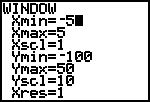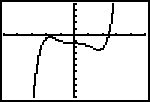Online Grapher
Hyperglossary
Test
Yourself
before submitting graded
quiz
Graded Assignment
Unit 3 - Polynomials and Rational Functions
This chapter focuses on analyzing polynomials and rational functions, their roots, asymptotes . Use the graphics calculator to help you with the mechanics of this chapter.
![]() Graphing
Calculator Skills needed for this chapter.
Graphing
Calculator Skills needed for this chapter.
Section 3.1 Quadratic Function
This section continues where the last chapter left off in the study of quadratics. It explores shifting and stretching of the curve along with vertices, axies of symmetry, maximums, minimums, roots (zeros) and comparison of the forms of the Quadratic Function.
f(x) = ax2+ bx + c vs. f(x) = a( x - h)2 + k
You should be able to:
Use completing the square method to convert a quadratic function to standard form.
Find the vertex , axis of symmetry, y-intercepts, and zeros of a quadratic function.
Click on the logo to explore vertices
Click on the logo to explore intercepts, zeros, and symmetry
Predict the stretching, and shifting from a quadratic given in Standard form
Explore vertical and horizontal shifting
Find the function, given the vertex and a random point.
Find the maximum or minimum of a parabolic function
(using -b/2a formula and the max min functions of the calculator.)
![]() Click on the logo
to explore Parabolas
Click on the logo
to explore Parabolas
 Internet
Link for Quadratic Functions
Internet
Link for Quadratic Functions
 Click on the icon to explore
Parabolas
Click on the icon to explore
Parabolas
Section 3.2 Polynomials of Higher Degree
This section explores polynomials of degree higher than 2. You will learn to analyze and explore of these functions graphically.
You should be able to:
![]() Sketch the graph on a calculator adjusting the viewing
windows to include relative maxima, minima,
and zeros.
Sketch the graph on a calculator adjusting the viewing
windows to include relative maxima, minima,
and zeros.



![]() Find a
polynomial, given the zeros.
Find a
polynomial, given the zeros.
![]() Dermine
whether the function is odd or even and make assumptions about end behavior
of the polynomial given the zeros.
Dermine
whether the function is odd or even and make assumptions about end behavior
of the polynomial given the zeros.
![]() Use
the calculator to find relative maxima, minima, and
zeros using the
Intermediate Value
Theorem.
Use
the calculator to find relative maxima, minima, and
zeros using the
Intermediate Value
Theorem.
Section 3.3 Real Zeros of Polynomial Functions
This section explains the methods used to find the real zeros of a polynomial function. Synthetic division is used repeatedly.
You should be able to:
![]() divide polynomials using long division and synthetic
division.
divide polynomials using long division and synthetic
division.
![]() Use the remainder
theorem to help factor a polynomial
Use the remainder
theorem to help factor a polynomial
![]() Use the factor
theorem to help find the zeros of a polynomial
Use the factor
theorem to help find the zeros of a polynomial
![]() Use the Rational Zeros
Test to find the possible rational zeros
Use the Rational Zeros
Test to find the possible rational zeros
![]() More info on finding
zeros.
More info on finding
zeros.![]()
©Joan Bookbinder 1998 -2002 All rights reserved